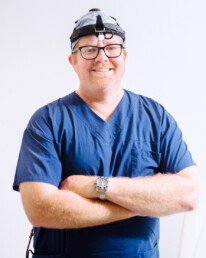Temporomandibular Joint Surgery (TMJ)

What is the Temporomandibular Joint (TMJ)
The temporomandibular joint (TMJ) is located where the lower jaw (mandible) attaches to the base of your skull. The TMJ is a unique joint called a ginglymoarthrodial joint. This allows your mouth to open and close and move forwards and backwards while also allowing movement from side to side.
A disc within the TMJ acts as a shock absorber and protects the bones from wear and tear. The Temporalis, Masseter and Pterygoid muscles attached to the TMJ control its position and jaw movements during talking, chewing and swallowing.
What are the symptoms of TMJ disorder?
A TMJ disorder can affect one or both joints. Damage may occur to the bones, disc, muscles or surrounding soft tissues. These disorders can cause pain, clicking, grinding, locking, dislocation of the joint, facial pain and/or headache.
Symptoms may range from mild to severely debilitating. People may have a wide range of symptoms.
Signs and symptoms may include:
- Pain on opening, chewing and yawning, particularly when opening widely
- Limitation in opening of the mouth (Trismus)
- A stuck or locked jaw (Closed lock)
- Clicking, grinding or popping noises from the TMJ
- A limited range of jaw movement
- Swelling over the joint or face
- Pain in or around the ears and cheeks
- Headaches, migraines and nausea
- An uncomfortable bite
- Inability for the front teeth to close together
Four surgical procedures are commonly used to treat TMJ disorders:
- Arthrocentesis – A minor procedure to wash out the jaw joint, removing inflammatory mediators and injecting steroid or hyaluronic acid to reduce inflammation and promote lubrication.
- Arthroscopy – A minor procedure to wash out the jaw joint while using a specialised camera to assist in diagnosis and removal of scar tissue and inflammatory mediators. This includes injecting steroid or hyaluronic acid to reduce inflammation and promote lubrication.
- Discectomy – An open procedure to remove of the diseased disc from the joint, replacing it with fat from the belly to improve symptoms and function.
- TMJ Replacement – An open procedure to remove the diseased joint completely and replace it with a customised titanium joint.
How do you treat TMJ disorders?
At your initial consultation, Dr Tuckett will take a thorough history, perform a comprehensive examination and review any x-rays or CT scans which your Dentist or GP may have organised. He will advise if any further investigations are required.
Dr Tuckett will explain to you whether conservative management or surgical management is appropriate in your case. If indicated, he will discuss the options for surgical management of your condition and discuss the procedure and any associated risks in depth. He will also advise you of what to expect in the post-operative period.
What does TMJ treatment involve?
As most TMJ disorders are temporary and do not usually worsen, simple and conservative treatment is often all that is required.
Many TMJ disorders can be treated without surgery by using pain relievers, anti-inflammatories or relaxing medications. This is usually in combination with physiotherapy and may include the use of a custom type of mouthguard called an occlusal splint.
A team approach to treatment is often needed. It may involve input from Dr Tuckett, your dentist and healthcare professionals such as a physiotherapist, pain specialist or psychologist.
The basic aims of surgery are to reduce or eliminate symptoms and improve jaw function. Surgery is indicated only after all conservative options have been trialled or a significant internal problem with the TMJ has been diagnosed.
Where will I have my TMJ surgery?
All surgical TMJ procedures are performed in hospital under general anaesthetic. You will be asleep for the duration of the procedure. You will be admitted on the day of your procedure and usually will be discharged the same day for minor procedures or the next day for more involved procedures following review by Dr Tuckett.
How long is the recovery after TMJ surgery?
The postoperative recovery period varies among patients but is usually about two weeks. Although pain in the TMJ usually starts to subside within three days after surgery, swelling and discomfort may continue for a while. Swelling is normal after any surgery and usually lasts about two weeks.
Physiotherapy, particularly jaw manipulation and exercise, is needed during the healing period.
After your procedure, Dr Tuckett will provide you with specific instructions regarding your post-operative care, general instructions are available here.

About Dr Joel Tuckett
Dr Tuckett is a contemporarily trained Oral and Maxillofacial Surgeon. He engages in a patient centred approach to ensure a caring and comfortable journey from initial consultation to discharge.
Dr Tuckett is and internationally published author in the fields of Facial trauma, Antibiotic stewardship, Radiotherapy induced Xerostomia, Parotid surgery and Head and Neck cancer. He is a senior lecturer at the University of Queensland where he educates both medical and dental students.
He currently has public appointments at the Princess Alexandra, STARS and Mackay Base hospitals where he works to train the new generation of surgeon.
